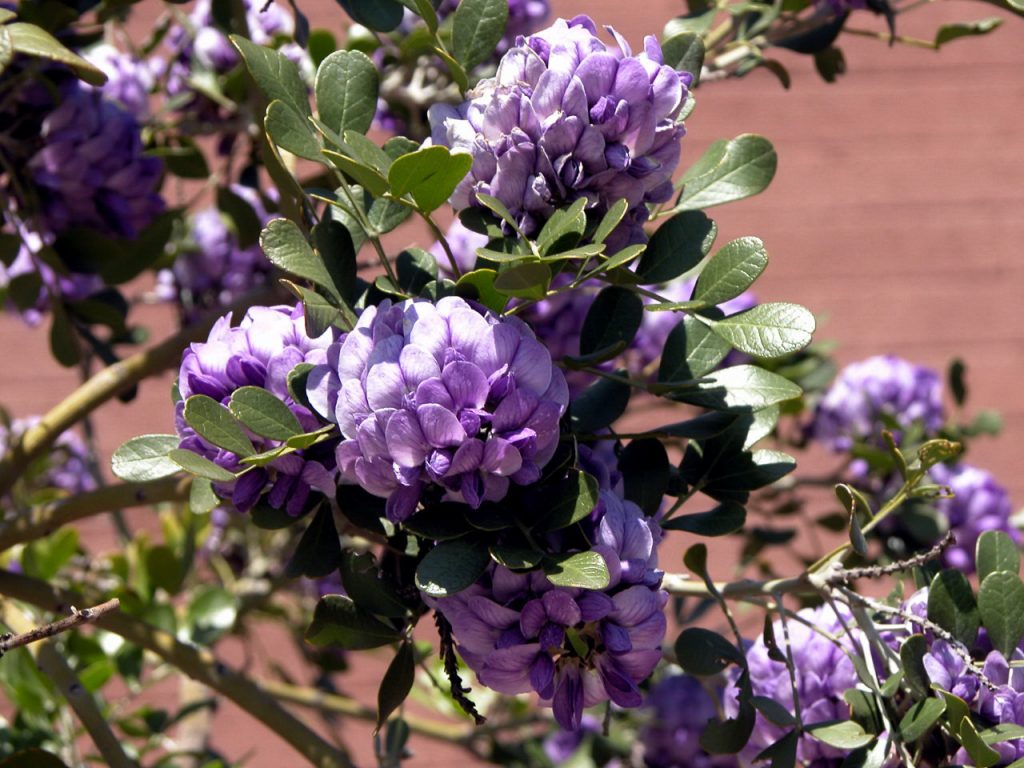Have you ever experienced the agony of sitting in a car that has been baking in an asphalt parking lot? If so, you understand the main value of trees in the desert; they provide much-needed SHADE! Trees benefit our environment in so many ways. They moderate our climate, provide wildlife habitat, improve air quality, and help conserve water by storing water and reducing storm run-off. Trees create microclimates that allow other plants, animals, and humans to flourish in our harsh desert environment. Luckily, there are many trees that thrive here, tolerating full sun and reflected heat, and preferring infrequent, deep summer irrigation. Best of all, the trees listed here provide glorious flower displays! Read on to decide which of these beauties are best suited for your project.
YELLOW FLOWERING TREES
Sweet Acacia (Acacia smallii, Acacia minuta, Acacia farnesiana)
In February and April, the Sweet Acacia, recently reclassified as Vachellia farnesiana, lives up to its common name by perfuming the air with masses of fragrant yellow-orange puffball flowers. This tree is extremely tough and will grow in almost any situation, from hot parking lots to turf areas. Its moderate size (to 25 feet tall and wide), fast growth rate, and attractive vase-shaped form make it a popular choice for desert landscapes. However, be aware that this tree is quite messy, and requires some maintenance. Sweet Acacia really wants to be a big bush, producing many thorny suckers at the base. Removal of these suckers, as well as selective pruning, is required to develop an upright tree form. Sweet Acacia should be kept away from swimming pools, as its plump, dark brown seed pods can create quite a bit of litter. Sweet Acacia is cold hardy to 10 degrees F and sheds its foliage in the winter. As you can see, Sweet Acacia has a bit of an identity crisis and is sold in the nursery trade under many different botanical names.
Cascalote (Caesalpinia cacalaco)
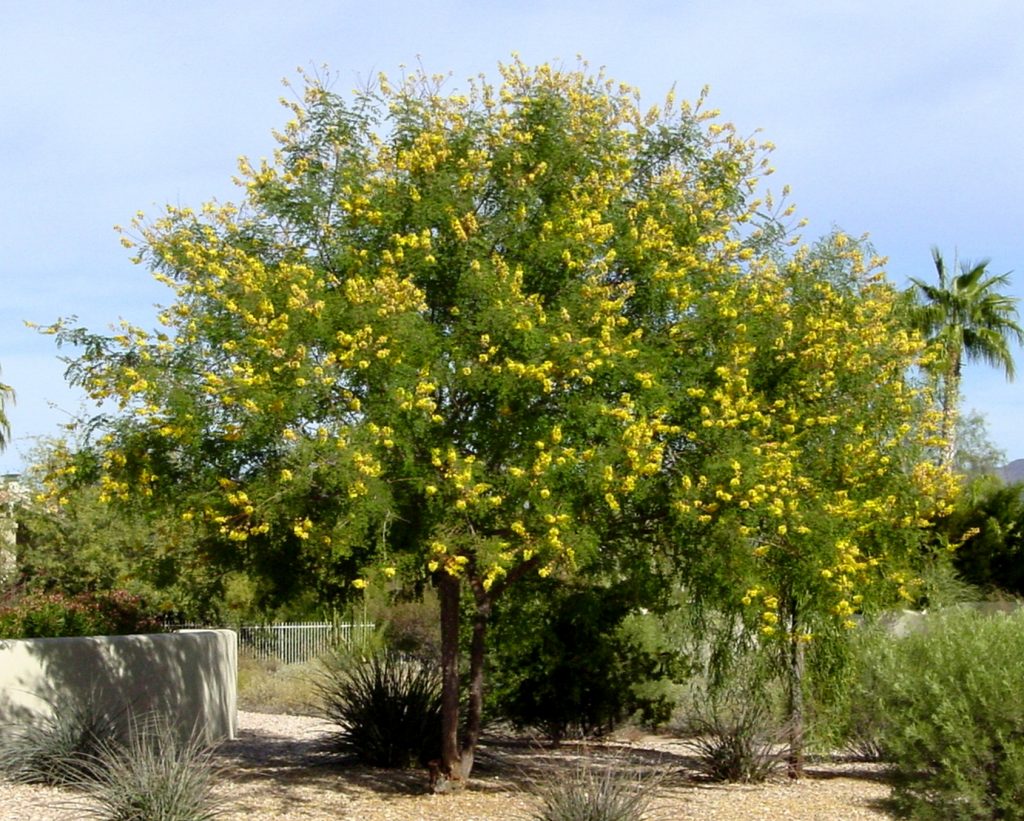
If you’ve been looking for a winter-blooming patio tree, consider planting a Cascalote. This species, recently reclassified as Tara cacalaco, will produce beautiful yellow flowers in fall and winter. Pair it with Lantanas for year-round color. It’s a small, vase-shaped tree that will top out at 15 to 18 feet tall, with a matching spread. Its lush green foliage provides an effective backdrop for the abundant yellow flower spikes. Younger branches are usually a reddish-brown color and are adorned with rose-like thorns. The thorns are not as prominent on older trunks and branches. Like the Sweet Acacia, this plant tends to grow as a big shrub but can be trained into a lovely multiple-trunk tree. Cascalote is hardy to about 25 degrees F and is mostly evergreen in the low deserts. This tree is sometimes a challenge to locate, but will be well worth the search! You can also now find a thornless cultivar named Cascalote “Smoothie.”
Palo Verdes (Parkinsonia species)
Beginning in March, the Palo Verde trees provide us with a spectacular show of color. In Mexico, this experience is called ‘lluvia de oro’, or ‘shower of gold’. The Blue Palo Verde (Parkinsonia florida) blooms first, producing incredible masses of bright yellow flowers. In two or three weeks, it is followed by the Foothill Palo Verde (Parkinsonia microphylla) and Palo Brea (Parkinsonia praecox) Note that Palo Verde’s were previously categorized in the Cercidium species. A newer selection, the ‘Desert Museum’ Palo Verde (Parkinsonia hybrid ‘Desert Museum’), has the longest bloom period, flowering from March through early summer. The name ‘Palo Verde’ literally translates to ‘Green Stick’, describing the unusual green branches and trunks of these desert trees. All four of these Palo Verdes should be planted in full sun exposures and well-drained soil. They all produce nice broken shade, which is ideal for the understory growth of many desert-adapted shrubs and perennials. Severe pruning should be avoided in the summer, as exposed trunks are susceptible to sunburn. Aside from the abundant flower production, litter from these trees is not a huge problem. The seed pods fall within a three week period in June or July and are easily cleaned up. They all have thorns, except for the ‘Desert Museum’ clone. The Palo Verdes also provide a haven for desert birds. Any of the following Palo Verdes are great choices for desert gardens. Just avoid the Mexican Palo Verde (Parkinsonia aculeata), as it is very messy, brittle, and will reseed all over the place!
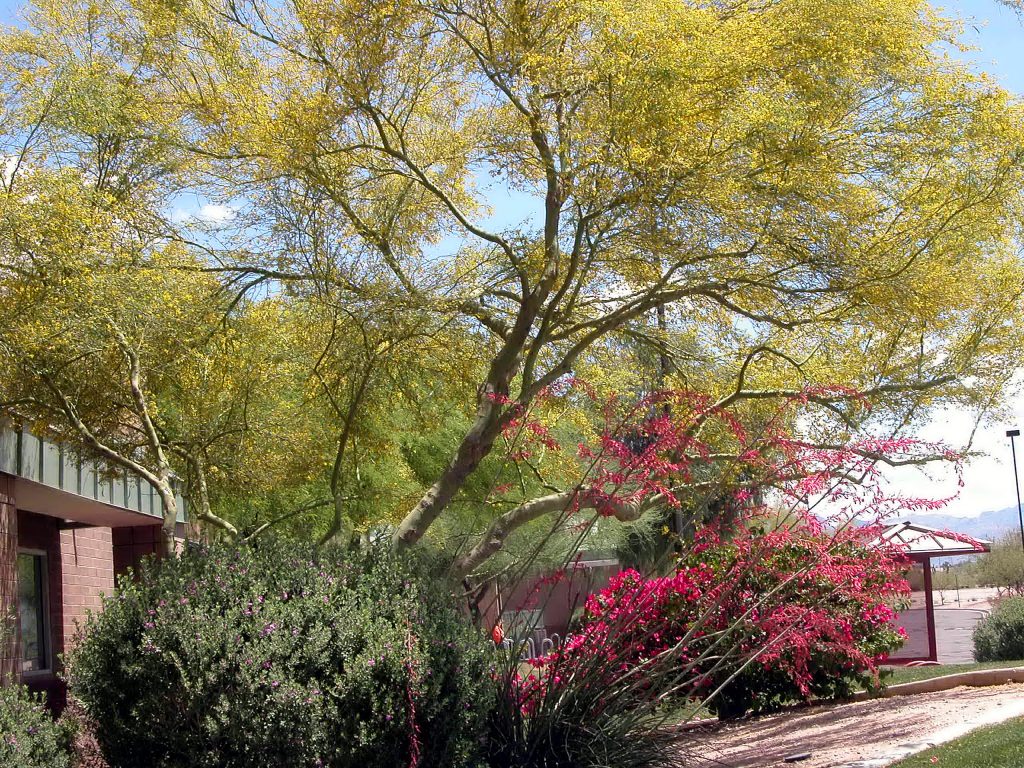
Blue Palo Verde (Parkinsonia florida)
This is the largest Palo Verde, to 35 feet tall and wide. It has blue-green stems and foliage, with the bark of older trunks turning a grey-brown color with age. Blue Palo Verde has a naturally spreading and weeping form and will require some shaping and pruning to develop a walk-under canopy. This native species is hardy to 15 degrees F.
Foothills Palo Verde (Parkinsonia microphylla)
This small native Palo Verde has a leisurely growth rate, eventually reaching a size of 20 feet tall and wide. Unless you’re quite patient, I would recommend planting as large a specimen as your budget will allow. Large trees salvaged from the desert have especially craggy, unusual forms. Foothills Palo Verde has lime green stems and leaves, and blooms in late April to May with pale yellow flowers. It is hardy to 10 degrees F.
Palo Brea, Sonoran Palo Verde (Parkinsonia praecox)
This extremely popular Palo Verde, the Palo Brea, has become the signature tree of downtown Phoenix, where it lines many of the roadways. Its strong sculptural form and smooth light green bark are quite unique and highly valued by landscape architects. Careful pruning can easily develop a walk-under canopy to 25 feet tall and wide This tree is native to warmer regions of Mexico, and is only hardy to 22 degrees F.
‘Desert Museum’ Palo Verde (Parkinsonia hybrid ‘Desert Museum’)
Although it is relatively new to the nursery trade, the ‘Desert Museum’ was first introduced in 1987 by the Arizona-Sonora Desert Museum in Tucson. This hybrid Palo Verde is thornless, has a longer bloom period and larger flowers than the other species, and grows quite rapidly to 25 feet tall and wide. The ‘Desert Museum’ clone is hardy to 17 degrees F.
PINK TO PURPLE FLOWERING TREES
Desert Willow (Chilopsis linearis)
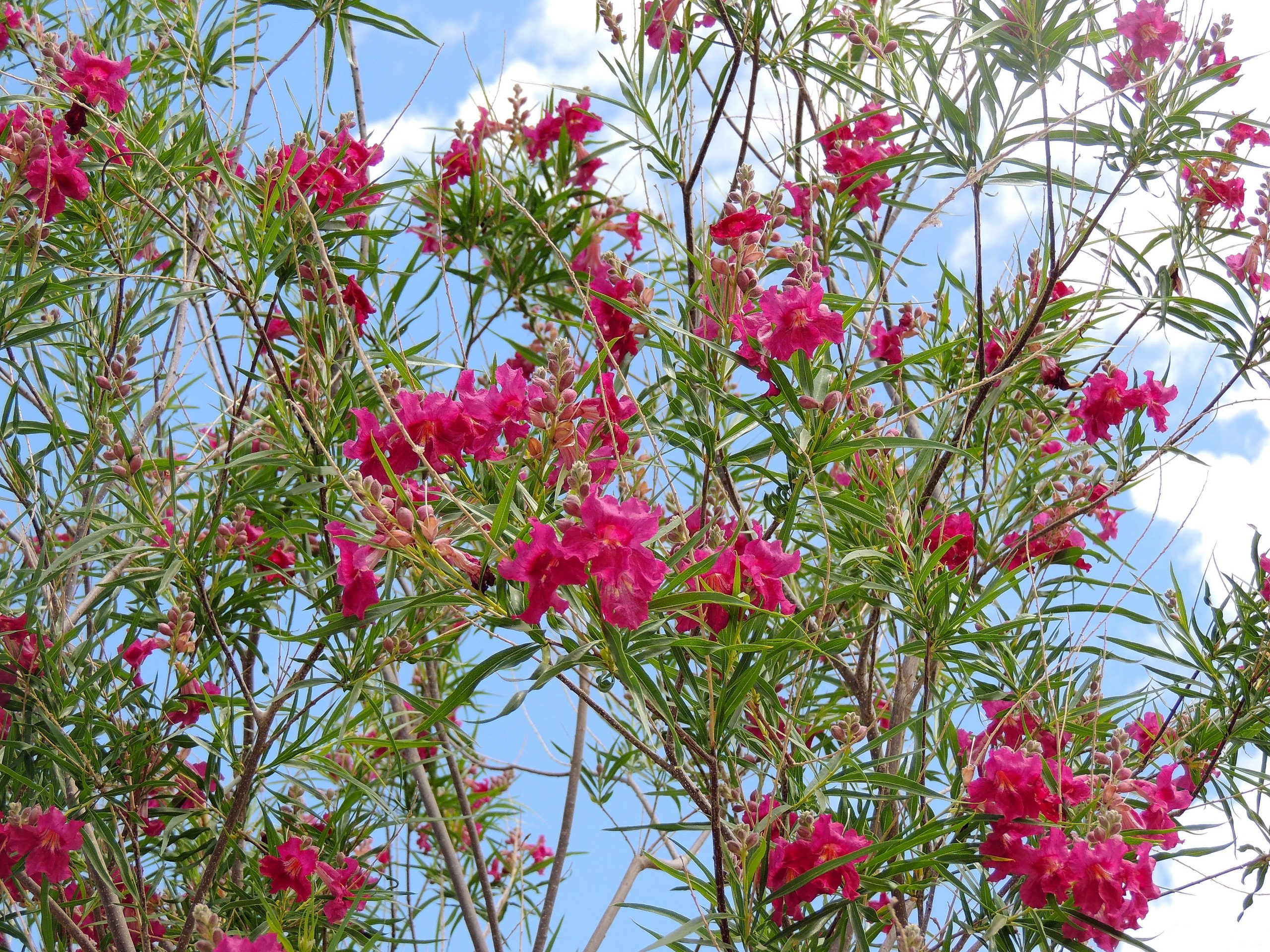
Native along dry washes in the southwestern U.S. and northern Mexico, this delicate-looking tree can grow to 25 feet tall and wide. During the spring, summer, and fall it has long, narrow green leaves reminiscent of a willow. Because the leaves fall off in the winter, this thornless tree is a great choice for south and east exposures. In the summer the leaves shade the house, but in the winter the open canopy allows the sun to shine through. From late spring to early fall, the Desert Willow is covered with clusters of fragrant orchid-like blossoms, ranging in color from white to deep pink. Mountain States has three named clones; Desert Diva™, Lucretia Hamilton™ and Warren Jones™ as well as other selected varieties like ‘Bubba’ and ‘Art’s Seedless.’ The flowers attract bees and hummingbirds. After blooming, long narrow seed pods tend to hang on the tree through the winter. The Desert Willow suckers at the base, and will require some pruning and shaping to develop a walk-under canopy. Chilopsis linearis is hardy to at least 0º F.
Texas Mountain Laurel (Sophora secundiflora )
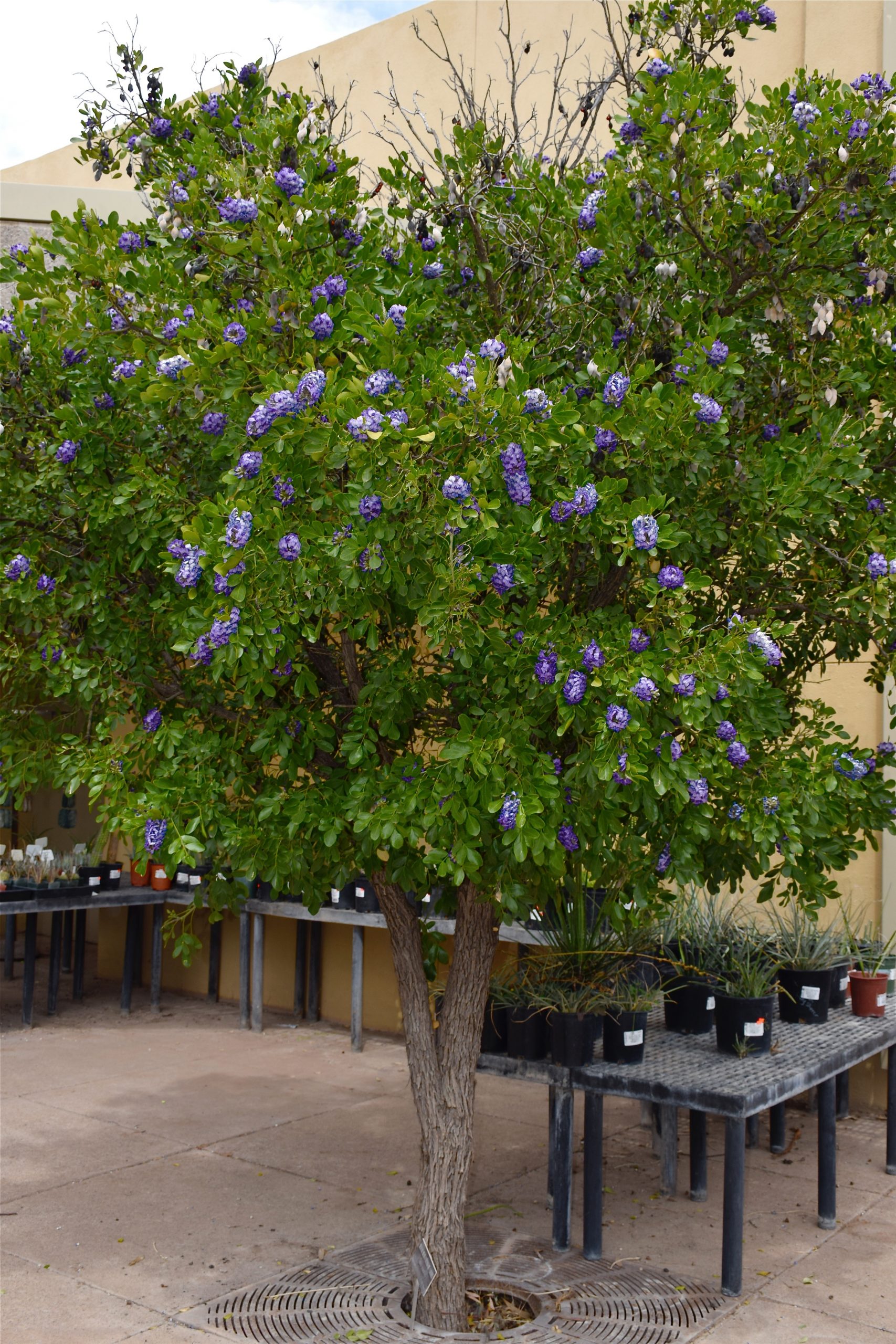
Texas Mountain Laurel, (recently reclassified to Dermatophyllum secundiflorum), can be grown in its natural shrubby form or can be trained into a small tree by removing the lower branches.If you catch a whiff of grape bubble gum on the air in February and early March, look around to see if there is a blooming Texas Mountain Laurel nearby. The large purple clusters of wisteria-like flowers look as good as they smell (see featured photo in upper right). Most Texas Mountain Laurels have glossy green foliage, providing a perfect foil for these showy blossoms. ‘Silver Peso’, a clone with silver-grey foliage, is available in limited quantities. Texas Mountain Laurel is evergreen, thornless, and is one of the cleanest small trees around. It is a good choice for patio areas, growing slowly to 15 feet tall and wide.
This popular tree is often difficult to find in large sizes, so you might have to plant a five gallon and wait patiently for it to develop a canopy. Deep, infrequent summer irrigation will encourage faster growth. One word of caution: this plant produces thick, hard seed pods which contain poisonous orange-red seeds. However, the seed pods are very difficult to break open. (I finally broke one open by jumping up and down on it repeatedly.) The late Jim Wheat, a Phoenix landscape architect, recalls that when he was growing up, kids called them ‘sting beans’. If you rub the seeds on rough concrete and touch your skin, you’ll find out why. Ouch! If you’re concerned about the seeds, simply clip off the seed pods before they mature. Texas Mountain Laurel is very cold-hardy, to at least 10 degrees F.
Chaste Tree, Monk’s Pepper Tree (Vitex agnus-castus)
Long, narrow spikes of purple flowers cover this plant in the summer months. Although the flower color can range from white to dark purple, most trees have been selected for the darker flower color. To be sure, try to select this plant when it is blooming. These fragrant flowers attract bees, butterflies, and hummingbirds. After blooming, narrow spikes of round, dark brown sees are produced. Monks in southern Europe and Asia, where this tree is native, reportedly used the seeds of this plant as a substitute for pepper. Unfortunately, this tree is fairly messy, shedding all of its leaves in the fall, and dropping old flowers and seeds throughout the year. However, its aromatic green leaves and long, profuse bloom period go a long way toward making up for the litter! Chaste Tree is very shrub-like but can be shaped into a tree form. Mature trees in older Phoenix neighborhoods are about 25 feet tall and wide. Chaste tree handles our hot summer heat like a champ, as well as tolerating temperatures below 0º F.
A final thought about trees from the Arizona Community Tree Council:
The best time to plant a tree was 20 years ago, the second-best time is NOW!
Here are some other tree articles that you might be find interesting:
- Tired of Skimming and Cleaning? 10 Pool-Friendly Shade Trees
- Small Space? Try Using Small, Desert-Adapted Trees
- At Stake: Securing Your Tree’s Future
Check out the rest of our Plants of the Month to find the perfect low-water-use plant for your landscape.
From time to time, Water – Use It Wisely features guest bloggers who write about topics related to water and water conservation. The author of this blog is Mountain States Wholesale Nursery, a wholesale plant nursery in Arizona. For 48 years, Mountain States has grown and made available desert-adapted plants and durable natives that add beauty, color, and variety to Southwest landscapes.


